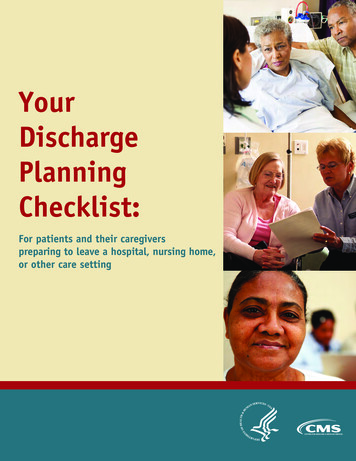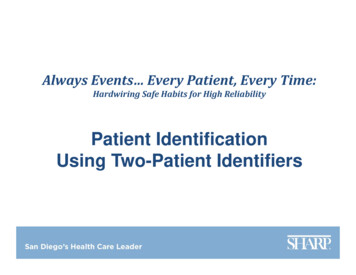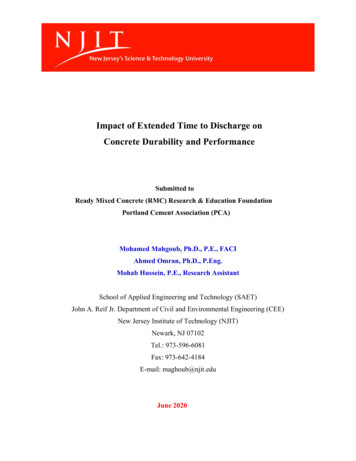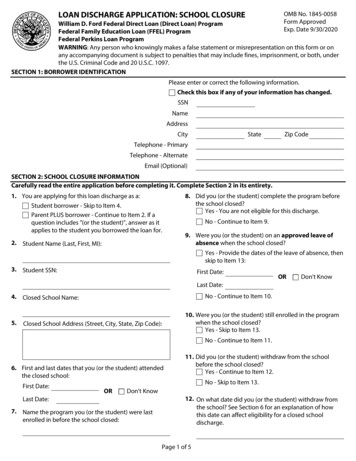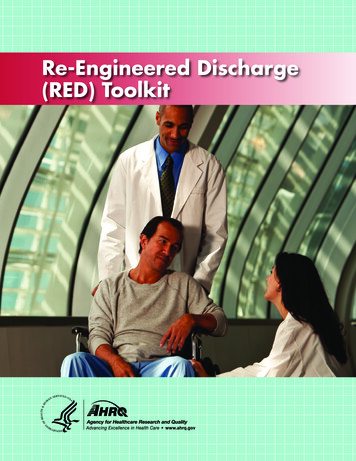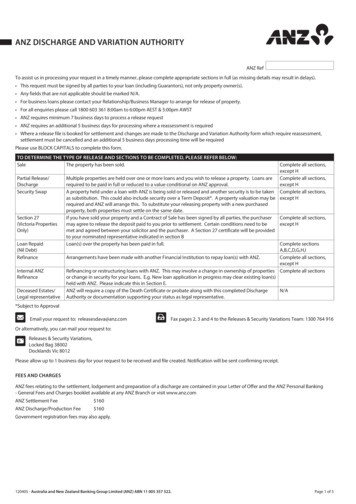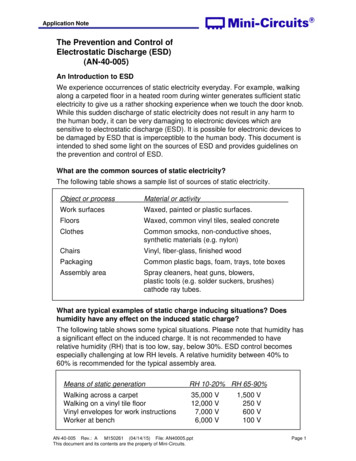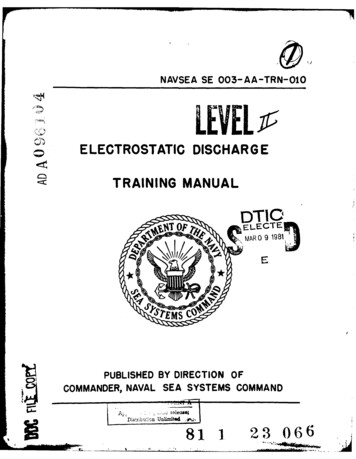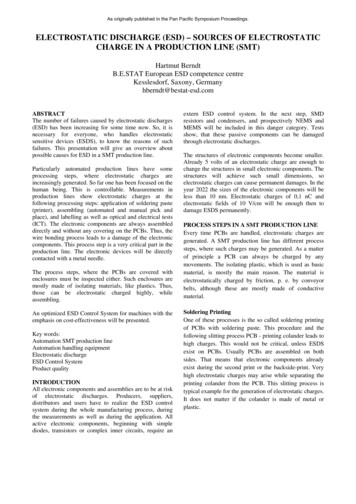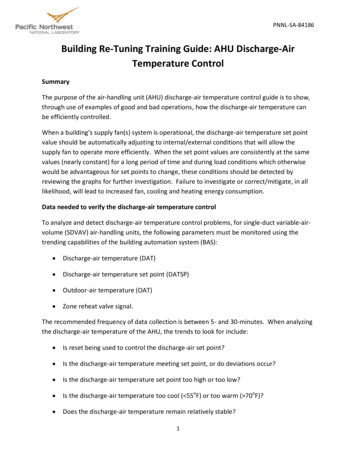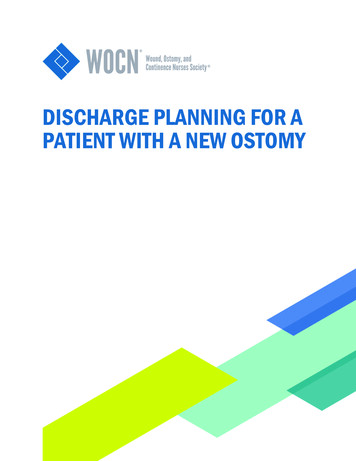
Transcription
DISCHARGE PLANNING FOR APATIENT WITH A NEW OSTOMY
DISCHARGE PLANNINGFOR A PATIENT WITHA NEW OSTOMYBESTPRACTICEFORCLINICIANSintroduction and purposeAcomprehensive discharge plan for a patient with a newostomy includes teaching basic skills such as emptyingand changing the pouching system, providing informationabout ostomy management (e.g., diet/fluid guidelines, signsof potential complications, factors to consider regardingmedications, management of gas and odor), instructionsabout how to order supplies, manufacturers, assistingwith transitions of care, and providing information aboutresources for support and assistance. It is important toencourage involvement of a family member or caregiverwhenever possible when planning for a patient’s discharge.This document was originally developed by the Wound,Ostomy and Continence Nurses Society (WOCN ) as abest practice guide for clinicians providing ostomy care(Wound, Ostomy and Continence Nurses Society [WOCN],2004). The purpose of this updated document is to provideclinicians with a quick guide to the essential elements ofa discharge plan, which may be used to facilitate patienteducation and transitions of care.acknowledgmentsThis document was developed by the WOCN Society’s Clinical Practice Ostomy Task Force between February 2014 – June 2014.Anita Prinz, MSN, RN, CWOCN, CFCN,COS-C, CLNC, ChairVP of Clinical AffairsGo Mobile Health, Inc.San Diego, CAJacqueline Perkins, MSN, RN, ARNP,FNP-C, CWON, Past-ChairWound/Ostomy Nurse PractitionerVA Central Iowa Health Care SystemDes Moines, IAJanet Mantel, MA, RN-BC, APN,CWOCNWound Ostomy Continence NurseHoly Name Medical CenterTeaneck, NJJan Colwell, MS, RN, CWOCN, FAAN,Co-ChairAdvanced Practice NurseUniversity of Chicago MedicineChicago, ILHeidi Cross, MSN, RN, FNP-BC, CWOCNNurse Practitioner, Wound and OstomyCareUpstate University HospitalSyracuse, NYCynthia A. Walker, MSN, RN, CWONWound Ostomy Nursing SpecialistJohns Hopkins Bayview Medical CenterBaltimore, MDThe Wound, Ostomy and Continence Nurses Society suggests the following format for bibliographic citations:Wound, Ostomy and Continence Nurses Society. (2014). Discharge Planning for a Patient with a New Ostomy: Best Practicefor Clinicians. Mt. Laurel: NJ. Author.Copyright 2014 by the WOCN Society. Date of Publication: 12/12/2014. No part of this publication may be reproduced,photocopied, or republished in any form, in whole or in part, without written permission of the WOCN Society.
DISCHARGE PLANNING FOR A Pteach basic skillsProvide an initial demonstration of skills. Ask the patient or caregiver to participate. Ask the patient or caregiver to provide a return demonstration of each skill.How to empty the pouch. Empty when 1/3 to 1/2 full and before bedtime (WOCN, 2013, 2014). Use of the clamp, integrated closure or urostomy tap. Cleaning the end of the pouch using a tissue or wipe. For urostomies, open and close the tap, connect/disconnect with the use of an adapter to a nighttime drainagecontainer. Use the correct adapter for the brand of pouch when connecting the pouch to a drainage container(WOCN, 2014).How to change the pouching system. Gather supplies. Measure the stoma and cut or mold the skin barrier to fit the size/shape of the stoma. Remeasure the stomaperiodically for the first 6 to 8 weeks after surgery because the size of the stoma may change as swelling subsides. Cleanse the skin around the stoma with water and dry thoroughly. Avoid use of products that contain amoisturizing agent (e.g., premoistened cleansing cloths like baby wipes) that may interfere with adherenceof the pouching system. Inspect the stoma and peristomal skin for irritation, wounds, rashes, or changes. Contact the certified ostomynurse for peristomal skin problems. Use accessory products, if needed, to protect the peristomal skin or improve the pouch seal and increase thepouch wear time (e.g., paste, barrier rings). Remove the backing from the skin barrier and center the pouching system around the stoma and gentlypress into place on the peristomal skin to ensure a good seal. Apply the pouch to the skin barrier if using a2-piece system. Close the end of the pouch. Change the pouching system any time it leaks and at least every 3 to 7 days (WOCN, 2010, 2013, 2014). Weartime will vary based on the thickness and amount of effluent (e.g., urostomies and many ileostomies with liquideffluent may require the appliance to be changed more frequently).2
ATIENT WITH A NEW OSTOMYreview guidelines for general ostomy managementDiet and fluid guidelines according to the type of ostomy.COLOSTOMY, ILEOSTOMY, OR UROSTOMY. Initially after surgery, a low-residue diet may beindicated because of bowel edema. Consider eating small, frequent meals and maintainadequate fluid intake during the immediatepostoperative period. Chew foods well to optimize digestion and absorption. Check with the healthcare provider for specificrecommendations regarding diet/fluid intake. Consider a nutritional evaluation for all new ostomyinpatients.COLOSTOMY. Dietary modification is usually unnecessary becausenutritional absorption is generally not affected. Certain foods may create excessive gas and odor. To decrease gas during the immediate post-operativeperiod, avoid carbonated beverages, sippingthrough a straw, smoking, gas-producing foods,and skipping meals.ILEOSTOMY. Monitor the stomal output. Notify the healthcare teamif the output is greater than 1,200 ml per 24 hours.Prevention of fluid and electrolyte imbalances is veryimportant. Patients and caregivers should monitorileostomy output during times of increased loss (suchas gastroenteritis, vomiting, increased sweating). Infantsand children can have fluid imbalances that occurquickly. Instruct patients and caregivers on signs andsymptoms of fluid and electrolyte imbalances (ErwinToth & Doughty, 1992). The following foods may thicken stool: bananas, rice,applesauce, peanut butter, soda crackers, pasta,bread, marshmallows, and cheese (Willcutts & TougerDecker, 2013). High-fiber foods such as the following may cause ablockage: stringy and fibrous foods such as celery andasparagus, foods with nondigestible fibrous peels suchas apples and corn, raw cabbage, dried fruits, nuts,popcorn, meats with casings, mushrooms, coconut,and foods with large seeds (Bradshaw & Collins, 2008;Cronin, 2013; Erwin-Toth & Doughty, 1992).UROSTOMY. No dietary modification should be needed. Encourage a daily intake of 8 to 10 glasses of fluid perday, unless contraindicated. Some foods can increase odor such as asparagus, fishand spices. Medications can change the color of the urine.3
BEST PRACTICE FOR CLINICIANScontinuedSigns of potential complicationsto report/seek help from thehealthcare team. Inability to maintain the pouch seal for a predictableamount of time. A rash, lesion, or denuded peristomal skin that doesnot heal after 1 to 2 pouch changes. Separation of the stoma from the peristomal skin(WOCN, 2010). Changes in the color of the stoma such as darkmaroon or black that might indicate necrosis, or adeep red, white or yellow linear discoloration thatmight indicate trauma (WOCN, 2010). Changes in the appearance or length of the stoma(WOCN, 2010):» Increase in the length with protrusion/prolapse ofthe stoma.» Retraction of the stoma below skin level.» Narrowing of the lumen of the stoma that impairsdrainage. Prolonged abdominal pain, persistent nausea orvomiting, and abdominal distention. Changes in stomal output/function:» Blood in the stool/urine.» No fecal output for 2 or more days (colostomy).» No fecal output for 8 or more hours (ileostomy).» No urinary output for 6 or more hours (urostomy). Excessive thirst, concentrated urine, weakness,lethargy, and/or fecal output greater than 1,200 mlper 24 hours. Foul smelling or cloudy urine, fever, chills or backpain (urostomy).Factors regarding medications. Color of stool or urine may change with somemedications and foods. Enteric coated or extended release medicationsmay not be absorbed in a patient with an ileostomy.The patient should observe the contents of the fecalpouch for undissolved pills or capsules and notifytheir healthcare provider or pharmacist to determineif medication(s) should be changed to promoteabsorption. Instruct the patient to discuss medication questions/issues with their healthcare provider(s) or pharmacist.Management of gas and odor. Detectable odor is only anticipated when emptyingor changing the pouch. If odor is noticed when notemptying or changing the pouch, the adhesive sealor closure is compromised. Colostomy and ileostomy.» Pouches with filters allow excessive gas to exit thepouch without odor.» A liquid odor eliminator can be used in the pouchto decrease odor.» Excessive gas and odor concerns should bediscussed with the healthcare provider. Urostomy.» Rinse the nighttime drainage container with acommercial deodorizer or a cleaner/decrystallizer;or clean the drainage container (tubing andadapter) daily or every other day with a solutionof 1 part white vinegar to 3 parts water (WOCN,2014).» Replace soft drainage containers twice a monthand hard plastic jug containers every 3 months(WOCN, 2014).4
DISCHARGE PLANNING FOR A PATIENT WITH Aassist withtransitions of careinstruct how toorder ostomy suppliesand accessories Check with the insurance provider (includingMedicaid) for specifics about reimbursement criteriafor supplies and information about possible preferredproviders. Medicare Part B insured patients (Medicare.gov, n.d.).» When receiving home care, the home care agencywill supply the necessary supplies.» Any supplier can be used for supplies: aprescription may be required.» Medicare sets a monthly limit for the type andnumber of allowable supplies that are reimbursable. Uninsured patients.» Some manufacturers have programs for uninsuredpatients.» The United Ostomy Associations of America’saffiliated support groups may have donatedsupplies (see www.ostomy.org). Provide information about manufacturers of ostomysupplies and contact information (Table 1). Communicate care needs, level of independence inostomy management, and the required supplies toall caregivers and settings. Provide the patient with a minimum of five pouchingsystems and accessory items (e.g., paste, powder,barrier rings, etc.) at the time of discharge. Includea list of all supplies that are being used with themanufacturer’s name and order numbers. Refer the patient as indicated to home care serviceswith a certified ostomy care specialist. Provide follow-up appointments with healthcareproviders, including a certified ostomy carespecialist.provide informationabout availableresources Manufacturers (Table 1). Resources for support and assistance (Table 2).Table 1. Examples of Manufacturers with Contact InformationMANUFACTURERWEBSITETELEPHONE onvaTec, tomy.com1-800-582-0707Hollister, Inc.www.hollister.com1-888-740-8999Marlen Manufacturing& Development Companywww.marlenmfg.com1-216-292-7060Nu-Hope Laboratories, Inc.www.nu-hope.com1-800-899-50175
NEW OSTOMYBEST PRACTICE FOR CLINICIANSTable 2. Examples of Available Resources for Support and AssistanceORGANIZATIONBRIEF DESCRIPTIONWEBSITETELEPHONENUMBERAmerican CancerSocietyA worldwide non-profit organization that helps people stay well and get well;helps find cures and fight back against cancer; and offers support groups.www.cancer.org1-800-227-2345Crohn’s and ColitisFoundation ofAmericaA non-profit, volunteer-driven organization dedicated to finding the cures forCrohn's disease and ulcerative colitis; and offers support groups.www.ccfa.org1-800-932-2423Osto GroupA non-profit organization that provides free ostomy supplies: The recipientpays for shipping and handling.www.ostogroup.org1-877-678-6690United OstomyAssociations ofAmerica (UOAA)An association of affiliated, nonprofit, support groups who are committed tothe improvement of the quality of life of people who have, or will have, anintestinal or urinary diversion.www.ostomy.org1-800-826-0826Wound, Ostomyand ContinenceNurses SocietyA professional nursing society whose members provide and direct thecare of people with ostomies. The Society’s website can be searched usingthe “Patient Links” tab to find a nurse who is available for a referral orconsultation for ostomy service in or near a patient’s geographic haw, E., & Collins, B. (2008). Managing a colostomy or ileostomy in community nursing practice. British Journal of Community Nursing, 13(11), 514-518.Cronin, E. (2013). Dietary advice for patients with a stoma. Gastrointestinal Nursing, 11(3), 14-24.Erwin-Toth, P., & Doughty, D. (1992). Principles and procedures of stomal management. In B.G. Hampton & R.A. Bryant (Eds), Ostomies and continent diversions: Nursingmanagement (pp. 29-103). St. Louis: Mosby.Medicare.gov. (n.d.). Your medicare coverage. Durable medical equipment (DME) coverage. Retrieved July 22, 2014, from uipment-coverage.htmlWillcutts, K., & Touger-Decker, R. (2013). Nutritional management for ostomates. Topics in Clinical Nutrition, 28(4), 373-383. doi:10.1097/01.TIN.0000437411.43694.ebWound, Ostomy and Continence Nurses Society. (2004). Discharge planning for a patient with a new ostomy: Best practice for clinicians. Retrieved July 22, 2014, fromhttp://www.wocn.org/default.asp?page DischargePtOstomyWound, Ostomy and Continence Nurses Society. (2010). Management of the patient with a fecal ostomy: Best practice for clinicians. Mount Laurel, NJ: Author.Wound, Ostomy and Continence Nurses Society. (2013). Colostomy and ileostomy products and tips: Best practice for clinicians. Mount Laurel, NJ: Author.Wound, Ostomy and Continence Nurses Society. (2014). Urostomy products and tips: Best practice for clinicians. Mount Lau
best practice guide for clinicians providing ostomy care (Wound, Ostomy and Continence Nurses Society [WOCN], 2004). The purpose of this updated document is to provide clinicians with a quick guide to the essential elements of a discharge plan, which may be used to facilitate patient education and transitions of care. DISCHARGE PLANNING
